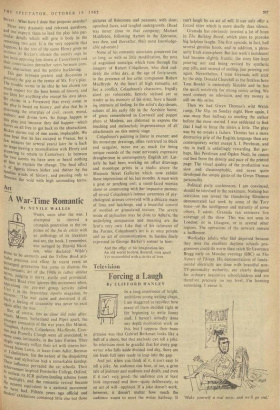A War-Time Romantic
By NEVILE WALLIS
WHEN, soon after the war, I attempted to interestim- pulses a youngish generation in the of the fin de siecle with an anthology of its literature and art, the book, I remember, was savaged by Harold Nicol- son, who declared Wilde's Prose to be unmanly and the Yellow Book atti- tudes precious and effete. In recent years an estranged generation has come to dismiss the n. eu-rornantic art of the 1940s in rather similar terms, judging it nervy, sterile and provincial. Herbert Read even ignores this movement when. appraising the pre-war group activity called wit I in the September Apollo magazine, he mourns: 'The war came and destroyed it all. Such nch a feeling of unanimity was never to exist again after the war. . • •' aut, of course, ties as close did exist after Yo,ards. Moore. Sutherland and Piper apart, the v7°Iinger romantics of the war years like Minton, t a°811an, Ayrton, Colquhoun, MacBryde, Crax- m and Prunella Clough were all associated, in scome cases intimately, in the later Forties. They ;tight variously stiffen their art with sinews bor- rowed from Lewis, or learn from Adler, Berman vu: .Tchelitchew. but the nature of the disquieting 1,sio.n and stylisation had a remarkable kinship. Their influence pervaded the art schools. Their achievement inspired Pembroke College, Oxford. t0inmate its JCR picture-lending scheme (soon multiplY), and the romantic revival became , e nearest equivalent to a national movement gs' have had. Fifteen years ago official and dealers' exhibitions contained little else but those
pictures of fishermen and peasants, with dour, squashed faces, and tangled undergrowth. (Read was never close to that company; Michael
Middleton, following Ayrton in the Spectator, was then, and thereafter, their most knowledge-
able advocate.) None of his romantic associates preserved for so long, or with so little modification, the note of anguished nostalgia which runs through the imagery of Robert Colquhoun, who died sud- denly the other day, at the age of forty-seven, in the presence of his artist companion Robert MacBryde. At the heart of high romantic art lies a conflict. Colquhoun's characters, frigidly aloof yet vulnerable, fiercely stylised yet as tender as his memory of his sister, have a haunt- int, intensity of feeling. In the artist's day-dream.
echoes of his early life in the Ayrshire home, of goats remembered in Cornwall and puppet plays at Modena, are distorted to express the touching and melancholy impermanence of all attachments on this mimic stage.
Colquhoun's painting is linear in essence; and his monotype drawings, often restricted to black and sanguine, move me as much for being unique records of the most nervously expressive draughtsman in contemporary English art. Lat- terly he had been working on offset drawings and monotype prints in a studio above the Museum Street Galleries which now exhibit these impressions of his last months. A man with a goat or perching owl; a snout-faced woman alone or communing with her impassive partner, all reveal Colquhoun's intense awareness of psy- chological stresses conveyed with a delicate maze of lines and hatchings, and a beautiful control of mottled or granulated texture. The severe mode of stylisation may be close to Adler's; the underlying compassion and meaning are the Scot's very own. Like that of his intimates of the Forties, Colquhoun's art is at once private and an act of communication, its burden finely expressed in George Barker's sonnet to him: And the effigy of his imagination lies An old world broken, fissured, torn apart Yet reassembled with a stroke of love.














































 Previous page
Previous page